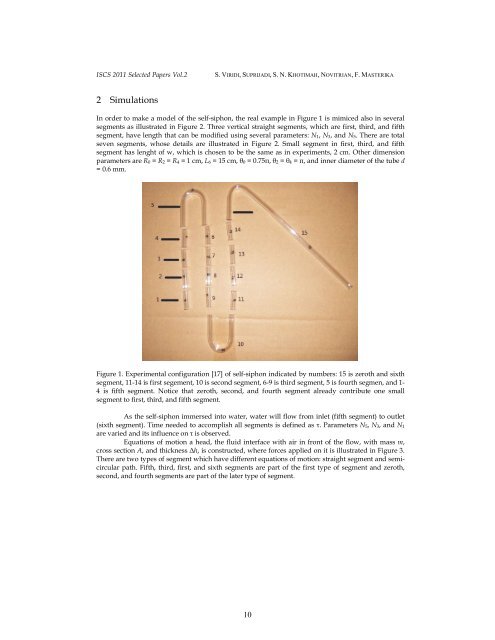RECENT DEVELOPMENT IN COMPUTATIONAL SCIENCE
RECENT DEVELOPMENT IN COMPUTATIONAL SCIENCE
RECENT DEVELOPMENT IN COMPUTATIONAL SCIENCE
Create successful ePaper yourself
Turn your PDF publications into a flip-book with our unique Google optimized e-Paper software.
ISCS 2011 Selected Papers Vol.2 S. VIRIDI, SUPRIJADI, S. N. KHOTIMAH, NOVITRIAN, F. MASTERIKA<br />
2 Simulations<br />
In order to make a model of the self-siphon, the real example in Figure 1 is mimiced also in several<br />
segments as illustrated in Figure 2. Three vertical straight segments, which are first, third, and fifth<br />
segment, have length that can be modified using several parameters: N1, N3, and N5. There are total<br />
seven segments, whose details are illustrated in Figure 2. Small segment in first, third, and fifth<br />
segment has lenght of w, which is chosen to be the same as in experiments, 2 cm. Other dimension<br />
parameters are R0 = R2 = R4 = 1 cm, L6 = 15 cm, θ0 = 0.75̟, θ2 = θ4 = ̟, and inner diameter of the tube d<br />
= 0.6 mm.<br />
Figure 1. Experimental configuration [17] of self-siphon indicated by numbers: 15 is zeroth and sixth<br />
segment, 11-14 is first segement, 10 is second segment, 6-9 is third segment, 5 is fourth segmen, and 1-<br />
4 is fifth segment. Notice that zeroth, second, and fourth segment already contribute one small<br />
segment to first, third, and fifth segment.<br />
As the self-siphon immersed into water, water will flow from inlet (fifth segment) to outlet<br />
(sixth segment). Time needed to accomplish all segments is defined as τ. Parameters N5, N3, and N1<br />
are varied and its influence on τ is observed.<br />
Equations of motion a head, the fluid interface with air in front of the flow, with mass m,<br />
cross section A, and thickness ∆h, is constructed, where forces applied on it is illustrated in Figure 3.<br />
There are two types of segment which have different equations of motion: straight segment and semicircular<br />
path. Fifth, third, first, and sixth segments are part of the first type of segment and zeroth,<br />
second, and fourth segments are part of the later type of segment.<br />
10


